Panasonic G1: Smallest and Lightest Interchangeable Lens Digital Camera
by Wesley Fink on September 15, 2008 1:00 PM EST- Posted in
- Digital Camera
Panasonic G1 Press Release
PANASONIC LUMIX DMC-G1: WORLD'S SMALLEST AND LIGHTEST DIGITAL INTERCHANGEABLE LENS CAMERA
World's First Micro Four Thirds System Camera Features Portability, Ease-of-Use and Colorful Blue and Red Models For Personalized Style and Active Lifestyles
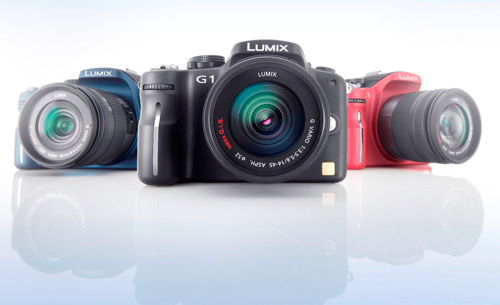
Secaucus, NJ - Panasonic announces the world's first Micro Four Thirds system camera, the LUMIX DMC-G1, the world's smallest and lightest digital interchangeable lens camera, weighing in at approximately 385 grams (0.85 lbs). Based on the new Micro Four Thirds System standard, the LUMIX G1 eliminates the internal mirror structure that defines digital single-lens reflex (DSLR) cameras, thus reducing the size and weight by nearly half. With the mirror-less system, the G1's flange back, which is the distance between the mount and the image sensor, has been reduced from 40mm - as specified in the Four Thirds System - to approximately 20mm.
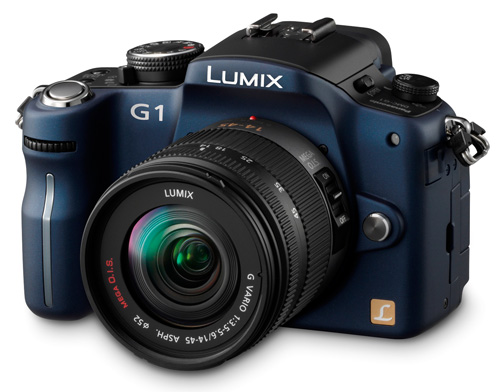
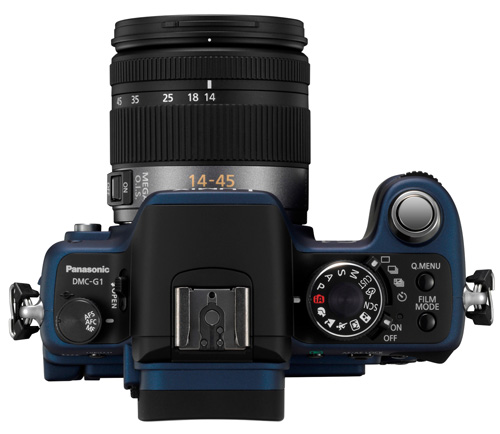
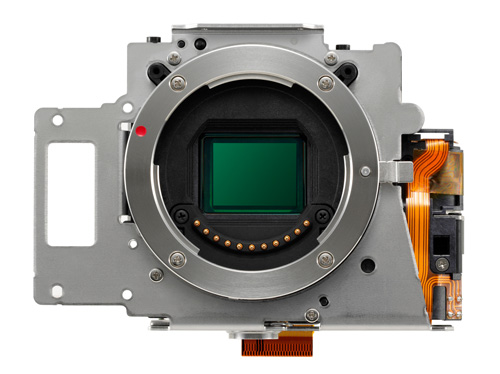
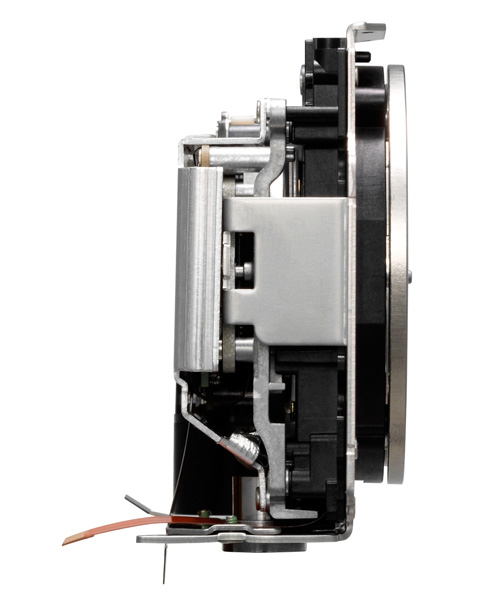
"With the LUMIX G1, we are filling a void that has existed for a long time in the digital camera market, because consumers wanted the power of an SLR, but previous models were bulky and inconvenient," said David Briganti, National Marketing Manager, Imaging, Panasonic Consumer Electronics Company. "The LUMIX G answers this challenge as consumers can benefit from the flexibility of changing lenses; a quick Auto Focus; and a sensor that produces high-quality photos. By packing all those powerful assets into an extremely compact body with easy-to-use features familiar to point-and-shoot users, we are excited about G, as it brings new possibilities to the consumer."
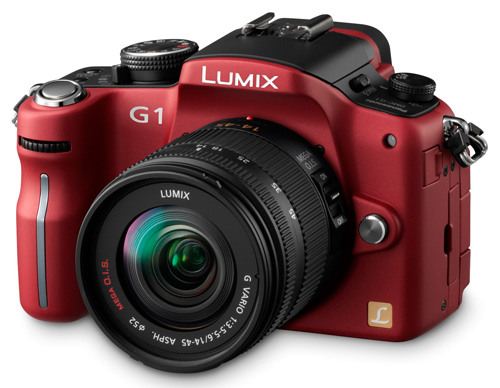
The LUMIX G1 is also the world's first interchangeable lens camera that will come with color variety - with availability in black, blue, and red models - allowing consumers to personalize their style through color, something very popular with point-and-shoot camera models.
For current Four Thirds users with a collection of lenses, an optional mount adapter will allow Four Thirds lenses to be compatible with the LUMIX G1. Also, today, with the introduction of the Micro Four Thirds System, Panasonic is announcing a wide-variety of accessories including: External Flash DMW-FL220 (GN22); PL Filter: DMW-LPL52; Mount Adapter: DMW-MA1; Battery Pack: DMW-BLB13; DC Cable: DMW-DCC3; Soft Case: DMW-CG1; Soft Bag: DMW-BAG1; Shoulder Strap (Stylish) DMW-SSTG1-A/C/R; Shoulder Strap (Woven) DMW-SSTG2-W; Shoulder Strap (Leather) DMW-SSTG3-T. The G1 is also compatible with current accessories: External Flash: DMW-FL360 (GN36)/DMW-FL500 (GN50); ND Filter: DMW-LND52; MC Protector: DMW-LMC52; Remote Shutter: DMW-RSL1; HDMI mini Cable: RP-CDHM15 (1.5m), RP-CDHM30 (3.0m).

The G1's compact size can also be attributed to its electronic full-time Live View Finder, as opposed to a conventional optical viewfinder. The electronic Live View Finder, with an impressive and high-resolution 1,440,000-dot equivalent, allows the user to shoot the exact image the camera sees while also displaying information about the camera's settings through the viewfinder. The G1 also features a clever built-in eye sensor, so the camera can detect when the user is nearing the viewfinder and automatically switches off the LCD, thus conserving battery life. Also, the Live View Finder has a large 1.4x (0.7x on a 35mm equivalent) magnification and when using the G1 in manual focus mode, the frame in the viewfinder or LCD will enlarge by 5x or 10x (can adjust using the dial).
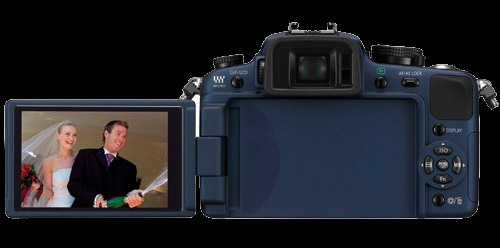
The Live View Finder and the bright 460,000-dot resolution, 3.0" LCD provide a 100% field of view, letting the user adjust settings before taking a shot, which is a great learning tool for consumers beginning to use manual controls, as they can visually confirm the effects of changed settings. The LCD can also swivel 180 degrees horizontally and 270 degrees vertically, giving the consumer flexibility to take high- and low-angle shots, and its Auto Power technology will automatically boost brightness by as much as 40% depending on the shooting condition so it remains visible in all lighting environments.
The G1 introduces a new Contrast AF (Auto Focus) function that is not only accurate and easy to use, but also very fast. Users can choose from a wide-range of AF modes, including multiple-area AF with up to 23 focus areas, 1-area AF with a selectable focus area, Face Detection, and AF Tracking. In the 1-area AF mode, the AF frame size can be changed by simply turning a dial. The G1 also has a Quick AF function that begins focusing as soon as the user aims the camera - no need to wait to press the shutter button halfway. This provides quicker focusing that can help capture the subject before the crucial moment passes.
Users familiar with point-and-shoot digital cameras, and new to the world of advanced interchangeable lens cameras, will benefit from Panasonic's Intelligent Auto (iA) mode. When in iA mode, the G1 will detect the shooting condition and automatically adjust for the ultimate shooting results. Panasonic's iA includes the following intuitive technologies.
- AF Tracking - Automatically tracks the subject as it moves, keeping it in focus without the need to hold the shutter halfway down.
- Intelligent Exposure - Helps prevent photos from being under- or over-exposed by analyzing the framed image and adjusting the brightness in areas that are too dark because of dim lighting, backlighting, or the use of the flash.
- MEGA O.I.S. - Gyrosensors detect hand-shake and the lens system shifts to compensate, helping to prevent hand movement from creating a blurry image.
- Intelligent ISO - Determines if the photo subject is moving and changes the ISO setting and shutter speed accordingly, thus giving a blur-free photo.
- Intelligent Scene Selector - Senses the ambient conditions and will automatically select the appropriate mode from Scenery, Portrait, Close-up, Night Portrait, or Night Scenery.
- Face Detection - Detects faces in the frame (up to 15 faces), even if they are moving, and selects optimal focus and exposure settings so portraits come out clear. Also features Digital Red-Eye correction.
The Panasonic LUMIX DMC-G1, a 12.1MP camera, also includes the following advanced features.
- Live MOS Sensor - Provides the best of both worlds with high image quality from a CCD sensor, and the lower-power consumption of a CMOS sensor. New technology makes it possible to read four channels of data simultaneously and deliver 60 frames-per-second full-time Live View images.
- Venus Engine HD - New imaging processor enhances noise reduction and provides independent gradation control for each of the R, G, and B colors.
- Supersonic Wave Filter Dust Reduction System - Designed to prevent dust from adhering to the image sensor by vibrating 50,000 times per second, the filter repels dust and other particles.
- My Color Mode - Users can freely adjust the color, brightness, and saturation while composing shots, allowing for more expressive and creative shots.
- HDMI Output - With an optional HDMI cable, the G1 can connect to an HDMI-capable High Definition television, such as a Panasonic VIERA Plasma or LCD. When connected to a VIERA, using VIERA Link capability, the TV's remote control can direct the slideshow on the G1.
- My Menu - This new tab automatically stores the five most recently used menu selections for quick, convenient retrieval. The custom-setting can also be used to program a frequently-used function which can be activated by pressing the down arrow on the cursor key. The color of the menu viewed on LCD can also be changed to three different colors: black, red, blue.
Pricing for the Panasonic LUMIX DMC-G1 and its Micro Four Thirds accessories will be announced in early October.










20 Comments
View All Comments
aeternitas - Monday, September 15, 2008 - link
I agree. Thats something they should use as a selling point more than anything else about the camera.aeternitas - Monday, September 15, 2008 - link
Them going on and on about how 'smooth' and 'accurate' ect ect this thing is and not mentioning the actual size of the CCD makes me roll my eyes.It’s pretty obvious to me this is a stunt to create some new type of camera sector. Compact SLR? Give me a break. That doesn’t even make any sense! By definition you’re going to have a lens, even if prime, that’s not going to fit comfortably in your pocket! Not only that, but if the camera itself is too light the lens will make it unbalanced on a tripod and in hand. I hope they were at LEAST smart enough to put the tripod threading further up closer to the lens itself under the camera, but that doesn’t change the in-hand issue.
If you think it’s a non-issue then you’re better off with a PoS camera, because SLRs are made to be comfortable through 1000s of images taken in a days’ time. Your hands will start to hurt, and isn’t that kind of contradictory to the purpose of this camera? Comfort? Or is there another purpose? I don’t really understand the point of this.
Let’s not forget the most important thing; Even the best consumer SLRS with full frame CCDs and superb SnR cannot resolve the resolution of the glass in front of them. What is the POINT of putting glass that even those cameras cannot resolve in front of this? It’s like putting 8GB of ram into a system that can only see 3.5.
Unless this thing is like 300$, it’s sort of an insult to any photographer with half a wit.
aeternitas - Monday, September 15, 2008 - link
I’d like to correct that the CCD was mentioned, skipped a page. My mistake. My point is made clearer though, as the pixel density is 5.Wesley Fink - Monday, September 15, 2008 - link
Yes, the pixel density is 4.98 MP/centimeter square as we pointed out, but the New Canon 50D is 4.5 which is not a hyge difference. You missed the point that the P&S densities are 28 to 36 MP per square centimeter which are a huge density difference compared to 4/3.In fact all of the APS-C sensors are all but the same when you look at the huge density advantage they hold over the best of today's point-and shoot models. Frankly people need to get past the emotion over the 4/3 sensor size and look at the facts, which are nowhere near the stark picture some like to paint. The 4/3 sensor is 75% the area of the the Canon sensor, and 6 to 8 times larger than the best P&S sensors.
Ajax9000 - Monday, September 15, 2008 - link
"Frankly people need to get past the emotion over the 4/3 sensor size ..."Agreed.
The smaller sensor in FT is claimed to be the equvilant of about 0.5-1 stop slower than the larger sensors in "conventional" dSLRs, but as can be seen with the Zuiko ED 12-60mm, the FT mount can enable faster lenses for a given size -- i.e. negating the supposed disadvantage. Lenses for mFT should be the same or better.
[quote]
Olympus ... have taken advantage of the Four Thirds sensor to deliver lenses which, for any given size, weight and cost, simply perform to a higher and more consistent standard than those optimized for larger formats ... The relatively fast maximum aperture (a half to a full stop faster than APS-C equivalents ...), coupled with the excellent wide-open performance, also allows the use of lower ISOs at equivalent light levels for maximum image quality.
[/quote]
From http://www.dpreview.com/lensreviews/olympus_12-60_...">http://www.dpreview.com/lensreviews/olympus_12-60_...
aeternitas - Monday, September 15, 2008 - link
The beef I have with this type of deal is there is no point. Honestly what’s the point? You can’t fit this anywhere a normal DSLR couldn’t go. It’s a diluted mix of SLR and point and shoots taking the worst qualities from each. Too big to be put anywhere advantageous over a normal DSLR and worse than even some of the worst pixel densities in the DSLR market.When you say it’s nowhere near the bad picture some people paint, you put yourself in a category of 'good enough'. People that spend 1000$ on glass and camera equipment do not do 'good enough' they do not want gimmicks. This is such a gimmick camera. The only interesting feature with practical use is that the glass is closer to the CCD.
Like I said, they can word things in a way to make the practical aspects of teh camera that are bad, sound good, but in the end they need to stop it and focus on the true pluses of this design.
strikeback03 - Monday, September 15, 2008 - link
The G1 at least is very similar in dimensions to the superzoom-class P&S cameras, and body-only similar in size to something like the Canon G9. So while this should take a big bite out of the superzoom market (at least once the micro 4/3 14-140 lens drops), I don't really consider it "pocketable". We have a couple of Canon S5IS cameras here in the lab, with the exception of large cargo pockets or maybe a pullover hoodie I don't have any pockets which could hold something that size comfortably. So if I am bringing some sort of camera bag anyway I don't see the problem with stepping up to the smaller traditional DSLRs from Olympus, Canon, Pentax, etc. But it will give Panasonic something different in the marketplace.tdawg - Monday, September 15, 2008 - link
Being so small, yet packing potentially high level image quality, would be nice for hiking and camping where one doesn't want to haul a more traditially-sized SLR and lenses, I would think. Also potentially nice for people that like to sneak camera gear into concerts and such. :)Personally, I don't like non-optical viewfinders on my SLRs, but as long as it has a viewfinder in addition to the rear LCD, it might not be too bad. The problem is that I can't see myself investing any money in any system other than my current Nikon system, so...
aeternitas - Monday, September 15, 2008 - link
"Haul"? Are you serious? This thing maybe weighs 2-300GRAMS less than a proper DSLR. If you can't handle 300grams to take obviously better photography you might as well use your cameraphone with that line of thought.expiringfrog - Wednesday, September 24, 2008 - link
I'm not sure how you conclude that a DSLR will take "obviously better photography (sic)". The G1 sensor is the same size as those used in all of Olympus' range of "proper DSLR's". Wesley points out quite correctly that this is not much smaller than 35mm full-frame and has perfectly decent imaging characteristics, certainly far better than the fingernail-sized sensors used in typical compact cameras. So this is certainly comparable to a "proper DSLR" in image quality. As for handling and speed, it all depends on what type of pictures you want to take: this isn't something you'd normally use to shoot motorsports, but on a hike it's as good as any DSLR, and will only get better as technology progresses.As for the weight difference of 300 grams, you've never met a serious hiker, have you?